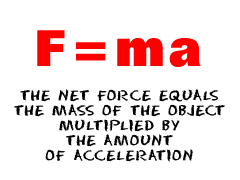Let's consider the scenario where the pink ice skaters are pushing the blue one as pictured.

Our own experience will tell us that these skaters will end up moving diagonally upwards and to the right. The reason for this is because the 2 forces can be added together. Because they are in differing directions, they need to be treated as a treated as a vector addition. When this is done, the resultant calculation corresponds to what we experience in the real world.
But what happens if no force is applied to an object? Believe it or not, just about everything on Earth is subjected to forces. Take for example your humble physics text book sitting next to you.

There is a downwards force due to gravity, but the book does not fall. This is because the table which it is sitting on exerts a reaction force upwards of equal value and opposite direction. The forces are balanced. This brings us to Newton's First Law of Motion:
A body at rest remains at rest, or, if in motion, remains in motion at a constant velocity unless acted on by a net external force.
So how does this apply to moving bodies? Fortunately NASA posted a really nifty pic for me to borrow.

If all of these forces are in balance, then the plane will remain at a constant altitude travelling at a constant velocity.
This is the scenario with your practical using suspended masses and vector boards. All the forces are balanced and so nothing moves.
However, when forces are unbalanced, things start to happen. This is summed up by Newton and his 2nd Law of Motion.
The acceleration of a system is directly proportional to and in the same direction as the net external force acting on the system, and inversely proportional to its mass.
That is:
More on this in future posts.

